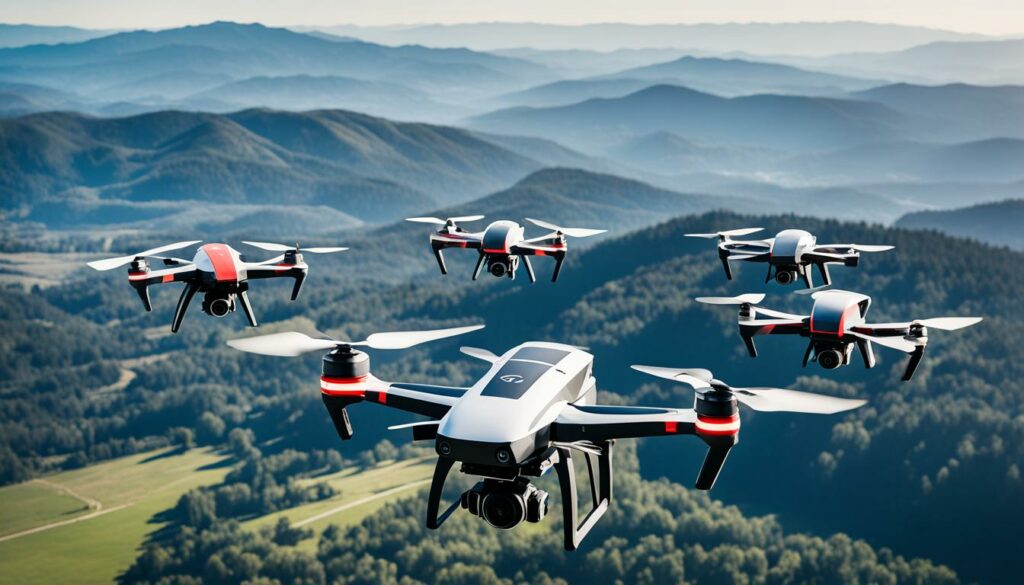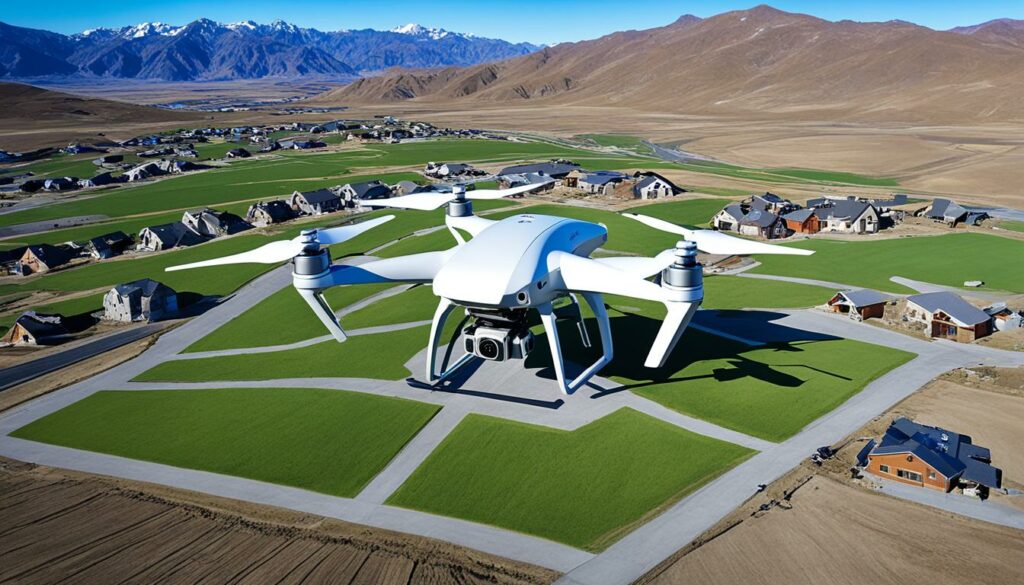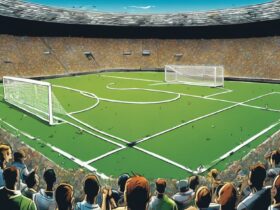Consumer drones have revolutionized the way we capture aerial imagery, deliver packages, and perform various tasks. But have you ever wondered how far these drones can actually fly? The maximum range of a drone depends on several factors, including its type, battery capacity, and flying style. In this article, we will delve into the fascinating world of drone flight distance and explore the capabilities of these aerial marvels.
Key Takeaways:
- The flight range of a drone can vary based on factors like drone type, battery capacity, and flying conditions.
- Multirotor drones typically have shorter flight ranges compared to fixed-wing drones due to their design.
- Factors like weather conditions, payload weight, and flying style can impact the overall flight range of a drone.
- Complying with regulations and flying within permitted airspace is crucial for maximizing the drone’s flight range.
- Advancements in battery technology, signal amplification, and range-extending accessories can help extend the flight distance of drones.
Factors Affecting Drone Flight Range
When it comes to the flight range of a drone, several factors come into play. From drone specifications to environmental conditions, each element can influence the distance a drone can fly. By understanding these factors, drone operators can optimize their flight range and make informed decisions. Let’s explore the key factors affecting drone flight range:
1. Drone Type
The type of drone is a crucial factor that impacts its flight range. Generally, lighter drones equipped with powerful motors tend to have longer ranges. These drones are designed to overcome air resistance more efficiently, enabling them to cover greater distances.
2. Battery Life
Battery life plays a critical role in determining the drone’s flight range. Opting for a drone with a larger battery capacity can extend the time the drone stays in the air, increasing its overall flying distance.
3. Controller Signal Strength
The strength and quality of the controller signal also influence the drone’s flight range. It is important to maintain a strong and stable signal between the controller and the drone to prevent signal loss or interference, maximizing the range.
4. Environmental Conditions
Environmental conditions, such as wind and rain, can significantly impact a drone’s power consumption and flight range. Windy conditions can cause increased energy consumption, reducing the range. Similarly, flying in rainy conditions may not be advisable due to potential damage to the drone’s components.
5. Compliance with Regulations
Adhering to regulations and flying within permitted airspace is crucial for ensuring maximum flight range. Complying with local drone regulations helps operators avoid legal issues and ensures safe and responsible drone operations.
By considering these factors and making appropriate adjustments, drone operators can optimize their flight range and achieve the desired results. However, it is essential to balance the range with safety considerations and adhere to local regulations in order to maintain responsible and legal drone operations.
Now, let’s take a closer look at the flight ranges of different drone types in the next section.
Drone Flight Ranges by Type
When it comes to drone flight ranges, the capabilities can vary depending on the type of drone. Let’s explore the different drone types and their respective flying ranges:
Toy Drones
If you’re a recreational drone enthusiast, toy drones offer a fun flying experience with limited ranges. These drones are designed for casual use and typically have a maximum range of up to 1,200 feet. While they may not offer long-distance capabilities, toy drones are perfect for beginners and indoor flying.
Consumer Drones
For those seeking more advanced control features and built-in GPS technology, consumer drones are a popular choice. These drones offer increased range capabilities, typically ranging from 1 to 3 miles. With consumer drones, you can enjoy exploring the skies and capturing breathtaking aerial footage.
Prosumer Drones
Bridging the gap between consumer and professional-grade drones, prosumer drones offer extended flight ranges. With ranges of 3 to 5 miles, these drones are suitable for enthusiasts and professionals alike. Prosumer drones often come equipped with advanced features and superior camera capabilities, allowing for high-quality aerial photography and video.
Professional Drones
Engineered for specific tasks and industries, professional-grade drones have the longest flight ranges available. These drones are designed to withstand demanding environments and can fly significant distances. Professional drones can reach ranges of up to 8 miles and beyond, making them ideal for aerial surveys, inspections, and other commercial applications.
Please note that these ranges are approximate and can vary depending on the specific model and technology used.
| Drone Type | Flight Range |
|---|---|
| Toy Drones | Up to 1,200 feet |
| Consumer Drones | 1 to 3 miles |
| Prosumer Drones | 3 to 5 miles |
| Professional Drones | Up to 8 miles and beyond |
Extending Drone Flight Range
When it comes to maximizing the flight range of your drone, there are several strategies you can employ. By implementing these techniques, you can extend your drone’s flight distance and unlock new possibilities for aerial exploration. Here are some effective methods to consider:
Upgrade Battery Performance
One of the most straightforward ways to extend your drone’s flight range is by upgrading its battery performance. Aftermarket batteries with higher capacities are available for many popular drone models. By investing in a battery upgrade, you can enjoy longer flight times and cover more ground during each flight.
Drone Range Extender
A drone range extender is a device that amplifies the signal between your drone and the controller, allowing for greater distances without losing connection. This can significantly increase the effective range of your drone, enabling you to explore farther and capture breathtaking footage. Consider investing in a reputable drone range extender to enhance your flying experience.
Flying in a Tailwind
When planning your drone flights, take advantage of favorable weather conditions and fly in a tailwind whenever possible. A tailwind, which blows in the same direction as your drone’s flight path, can provide a helpful boost in speed, enabling your drone to cover more distance while using less battery power.
Reduce Weight
The weight of your drone directly impacts its flight range. By reducing unnecessary accessories and payloads, you can make your drone lighter and more aerodynamic, resulting in increased efficiency and longer flight times. Analyze your setup and remove any non-essential items to optimize your drone’s performance.
Fly in a Cool Environment
Operating your drone in a cool environment can have a significant impact on its battery performance. Heat can negatively affect battery life, causing it to drain faster. When flying in warmer temperatures, the battery’s capacity may decrease, limiting your flight range. Choose cooler times of the day or locations with lower ambient temperatures for optimal battery performance.
Use a Solar Panel
A solar panel charger can be a game-changer for extending your drone’s flight range. By harnessing the power of the sun, you can recharge your drone’s battery while it’s in flight, effectively eliminating the need to land and recharge. This allows for longer flight times and greater exploration possibilities.
By employing these strategies, you can extend the flight range of your drone and push the boundaries of aerial exploration. Whether you’re an aerial photographer, a surveyor, or an adventure seeker, these techniques will help you capture stunning footage and uncover new perspectives from above.

| Methods to Extend Drone Flight Range | Benefits |
|---|---|
| Upgrade battery performance | Longer flight times |
| Drone range extender | Amplified signal for greater distances |
| Flying in a tailwind | Save battery power with wind assistance |
| Reduce weight | Increased efficiency and longer flight times |
| Fly in a cool environment | Optimal battery performance |
| Use a solar panel | Recharge battery while flying |
Regulations and Ethical Considerations
Flying drones, especially long-range ones, requires strict adherence to regulations and ethical considerations. In the United States, drone pilots must comply with the rules set by the Federal Aviation Administration (FAA) to ensure safe and responsible drone operations. These regulations include:
- Flying within visual line-of-sight
- Operating below 400 feet
- Maintaining a safe distance from airports and restricted spaces
It is crucial for drone operators to familiarize themselves with the specific regulations in their country of operation, as drone flight regulations may vary. By following these regulations, drone pilots can ensure the safety of their operations and minimize any potential risks.
Aside from regulations, there are also ethical considerations when using long-range drones. These include:
- Privacy and surveillance: Long-range drones equipped with advanced cameras and sensors have the potential to intrude on individuals’ privacy if utilized irresponsibly. It is important to respect privacy rights and avoid using drones for intrusive surveillance purposes.
- Safety and security: Operating long-range drones in a responsible manner is crucial to avoid endangering people, property, or airspace. Drone operators should prioritize safety and take necessary precautions.
- Accountability and transparency: As the use of long-range drones expands, it is essential for operators to maintain accountability and ensure transparency in their operations. Clearly communicating the purpose and intent of drone flights can help build trust with stakeholders.
By adhering to regulations and considering ethical implications, drone operators can foster a safe and responsible environment for using long-range drones.
Applications of Long-Range Drones
Long-range drones have revolutionized various industries by offering extensive coverage capabilities. With their ability to cover large distances, these drones have opened up a world of possibilities for applications in areas such as:
- Drone Delivery: One of the most significant applications of long-range drones is in the field of delivery. These drones can transport packages to remote or hard-to-reach areas efficiently and quickly.
- Inspection and Monitoring: Long-range drones are ideal for inspecting infrastructure, such as pipelines, power lines, and buildings. They can also be deployed to monitor wildlife, perform environmental surveys, and conduct search and rescue operations over vast areas.
- Surveillance and Mapping: Drones equipped with high-resolution cameras and sensors are invaluable for surveillance and mapping tasks. They can collect data, capture images, and create detailed maps over large territories.
- Research: Long-range drones are increasingly being utilized for scientific research purposes. Researchers can use these drones to collect data and samples from inaccessible or remote locations, providing valuable insights for various fields of study.
To illustrate the vast range of applications, consider the following example:
“Long-range drones are invaluable for conducting aerial inspections of critical infrastructure. For instance, in the energy sector, these drones can perform routine inspections of power lines and wind turbines, identifying potential faults or damage. This helps in ensuring the smooth operation of the infrastructure and minimizing downtime. The ability to cover large distances allows these drones to inspect extensive networks efficiently, saving time and manpower.”
Overall, the applications of long-range drones are diverse and constantly expanding. They offer enhanced capabilities for drone delivery, inspection and monitoring, surveillance and mapping, and research purposes. With ongoing advancements in technology, the potential applications for long-range drones are limitless.

Conclusion
In conclusion, the maximum distance a drone can fly is influenced by various factors such as the drone type, battery capacity, weather conditions, and flying style. By considering these factors, drone operators can optimize their flight range and make informed decisions about drone usage.
Adhering to regulations and guidelines is crucial to ensure safe and legal operations. It is important for drone operators to familiarize themselves with the rules set by regulatory bodies such as the Federal Aviation Administration (FAA) to prevent any safety hazards or violations.
Drones have diverse applications, ranging from delivery and inspection to surveillance and research. As technology continues to advance, the flight range capabilities of drones are expected to expand, opening up even more possibilities for their use in various industries.
In summary, understanding the maximum distance a drone can fly, optimizing its flight capabilities, and prioritizing safety considerations are key factors in harnessing the full potential of drones and maximizing their impact across different sectors.
FAQ
How far can a drone fly?
The maximum distance a drone can fly depends on various factors, including drone type, battery capacity, weather conditions, and flying style.
What factors affect the flight range of a drone?
The flight range of a drone can be influenced by factors such as drone type, battery life, controller signal strength, environmental conditions, and compliance with regulations.
What are the different flight ranges of drone types?
Drone flight ranges vary depending on the type of drone. Toy drones have limited ranges of up to 1,200 feet, while consumer drones typically have ranges between 1 to 3 miles. Prosumer drones have ranges of 3 to 5 miles, and professional drones can reach up to 8 miles and beyond.
How can I extend the flight range of my drone?
To extend the flight range of a drone, you can upgrade the drone’s battery, use a drone range extender to amplify the signal, fly in a tailwind, reduce the weight of the drone, fly in a cool environment, or use a solar panel charger.
What regulations and ethical considerations should I be aware of when flying long-range drones?
Flying drones, especially long-range ones, is subject to regulations and guidelines. It is important to comply with regulations set by authorities such as the Federal Aviation Administration (FAA). Ethical considerations include privacy and surveillance issues, safety and security concerns, and the need for accountability and transparency in drone use.
What are the applications of long-range drones?
Long-range drones have various applications, including drone delivery, inspection and monitoring, surveillance and mapping, and research purposes such as collecting data and samples from inaccessible areas.
How can I ensure safe and legal drone operations while maximizing flight range?
To ensure safe and legal drone operations, follow regulations and guidelines set by authorities, familiarize yourself with airspace restrictions, fly within line-of-sight, and comply with height and distance limitations. Adhere to ethical considerations and prioritize safety in all drone operations.














